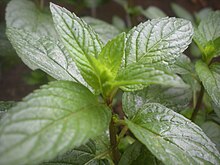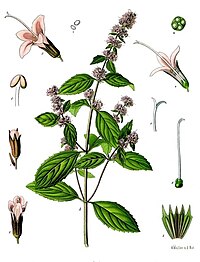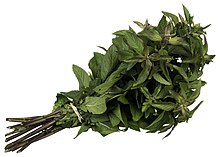Peppermint
From Wikipedia, the free encyclopedia
(Redirected from Mentha piperita)
For other uses, see Peppermint (disambiguation).
| Peppermint | |
|---|---|
 | |
| Peppermint (Mentha × piperita) | |
| Scientific classification | |
| Kingdom: | Plantae |
| (unranked): | Angiosperms |
| (unranked): | Eudicots |
| (unranked): | Asterids |
| Order: | Lamiales |
| Family: | Lamiaceae |
| Genus: | Mentha |
| Binomial name | |
| Mentha × piperita L. | |
Peppermint (Mentha × piperita, also known as M. balsamea Willd.[1]) is a hybrid mint, a cross between watermint and spearmint.[2] The plant, indigenous to Europe, is now widespread in cultivation throughout all regions of the world.[3] It is found wild occasionally with its parent species.[3][4]
Contents
[hide]Botany[edit]
Peppermint was first described in 1753 by Carl Linnaeus from specimens that had been collected in England; he treated it as a species,[5]but it is now universally agreed to be a hybrid.[6]
It is a herbaceous rhizomatous perennial plant growing to 30–90 cm (12–35 in) tall, with smooth stems, square in cross section. The rhizomesare wide-spreading, fleshy, and bare fibrous roots. The leaves are from 4–9 cm (1.6–3.5 in) long and 1.5–4 cm (0.59–1.57 in) broad, dark green with reddish veins, and with an acute apex and coarsely toothed margins. The leaves and stems are usually slightly fuzzy. The flowersare purple, 6–8 mm (0.24–0.31 in) long, with a four-lobed corolla about 5 mm (0.20 in) diameter; they are produced in whorls (verticillasters) around the stem, forming thick, blunt spikes. Flowering is from mid to late summer. The chromosome number is variable, with 2n counts of 66, 72, 84, and 120 recorded.[4][7][8] Peppermint is a fast growing plant once it sprouts, it spreads very quickly.
Ecology[edit]
Peppermint typically occurs in moist habitats including stream sides and drainage ditches. Being a hybrid, it is usually sterile, producing no seeds and reproducing onlyvegetatively, spreading by its rhizomes. If placed, it can grow anywhere, with a few exceptions.[4][8]
Outside of its native range, areas where peppermint was formerly grown for oil often have an abundance of feral plants, and it is considered invasive in Australia, the Galápagos Islands, New Zealand,[9] and in the United States[10] in the Great Lakes region, noted since 1843.[11]
Cultivation[edit]
Peppermint generally grows best in moist, shaded locations, and expands by underground stolons. Young shoots are taken from old stocks and dibbled into the ground about 1.5 feet apart. They grow quickly and cover the ground with runners if it is permanently moist. For the home gardener, it is often grown in containers to restrict rapid spreading. It grows best with a good supply of water, without being water-logged, and planted in areas with part-sun to shade.
The leaves and flowering tops are used; they are collected as soon as the flowers begin to open and can be dried. The wild form of the plant is less suitable for this purpose, with cultivated plants having been selected for more and better oil content. They may be allowed to lie and wilt a little before distillation, or they may be taken directly to the still.
Chemical constituents[edit]
Peppermint has a high menthol content. The oil also contains menthone and menthyl esters, particularly menthyl acetate.[12] Dried peppermint typically has 0.3-0.4% of volatile oil containing menthol (7-48%), menthone (20-46%), menthyl acetate (3-10%), menthofuran (1-17%) and 1,8-cineol (3-6%). Peppermint oil also contains small amounts of many additional compounds including limonene, pulegone, caryophyllene and pinene.[13][14]
Uses[edit]
It is the oldest and most popular flavour of mint-flavoured confectionery and is often used in tea and for flavouring ice cream, confectionery,chewing gum, and toothpaste. Peppermint can also be found in some shampoos, soaps and skin care products.
Menthol activates cold-sensitive TRPM8 receptors in the skin and mucosal tissues, and is the primary source of the cooling sensation that follows the topical application of peppermint oil.[15]
Peppermint flowers are large nectar producers and honey bees as well as other nectar harvesting organisms forage them heavily. A mild, pleasant varietal honey can be produced if there is a sufficient area of plants.
Medicinal use[edit]
Peppermint has a long tradition of medicinal use, with archaeological evidence placing its use as at ten thousand years ago, or longer.[citation needed]
Peppermint is commonly used to soothe or treat symptoms such as nausea, vomiting, abdominal pain, indigestion, irritable bowel, and bloating.[16][17][18]
One animal study has suggested that peppermint may have radioprotective effects in patients undergoing cancer treatment.[19]
The aroma of peppermint has been found to enhance memory and alertness,[20][21] although other research contests this.[22] Peppermint is used in aromatherapy.
Peppermint oil[edit]
Peppermint oil has a high concentration of natural pesticides, mainly pulegone (Found mainly in Mentha arvensis var. piperascens Cornmint, Field Mint, Japanese Mint and to a lesser extent-6,530 ppm in Mentha x piperita subsp. nothosubsp. piperita[23]) and menthone.[24]
The chemical composition of the essential oil from peppermint (Mentha x piperita L.) was analyzed by GC/FID and GC-MS. The main constituents were menthol (40.7%) and menthone (23.4%). Further components were (+/-)-menthyl acetate, 1,8-cineole, limonene, beta-pinene and beta-caryophyllene.[25]
Medicinal use[edit]
In 2007, Italian investigators reported that 75% of the patients in their study who took peppermint oil capsules for four weeks had a major reduction in irritable bowel syndrome (IBS) symptoms, compared with just 38% of those who took a placebo.[26] A second study in 2010, conducted in Iran, found similar results.[27] 2011 research showed that peppermint acts through a specific anti-pain channel called TRPM8 to reduce pain sensing fibres.[citation needed] The authors feel that this study provides information that is potentially the first step in determining a new type of mainstream clinical treatment for irritable bowel syndrome.[28]
According to the German Commission E monographs, peppermint oil (as well as peppermint leaf) has been used internally as an antispasmodic (upper gastrointestinal tract and bile ducts) and to treat irritable bowel syndrome, catarrh of the respiratory tract, and inflammation of the oral mucosa. Externally, peppermint oil has been used for myalgia and neuralgia. According to Commission E, peppermint oil may also act as a carminative, cholagogue, antibacterial, and secretolytic, and it has a cooling action.[29]
Enteric-coated peppermint oil capsules (Colpermin) has been used as an orally administered antispasmodic premedication in colonoscopy. The capsules were found beneficial in reducing total procedure time, reducing colonic spasm, increasing endoscopist satisfaction and decreasing pain in patients during colonoscopy.[30]
Similarly, some poorly designed earlier trials found that peppermint oil has the ability to reduce colicky abdominal pain due to IBS with an NNT (number needed to treat) around 3.1,[31] but the oil is an irritant to the stomach in the quantity required and therefore needs wrapping for delayed release in the intestine. This could also be achieved by using the whole herb or leaves, rather than the volatile components alone.
Due to the menthol constituent, topical use of peppermint oil around the facial or chest areas of infants and young children, especially around the nose, can induce apnea, laryngeal and bronchial spasm, acute respiratory distress with cyanosis, or respiratory arrest.[32] It is also used in construction and plumbing to test for the tightness of pipes and disclose leaks by its odor.[33]
Peppermint oil may cause or worsen heartburn.[citation needed]
Toxicology[edit]
The toxicity studies of the plant have received controversial results. Some authors reported that the plant may induce hepatic diseases (liver disease), while others found that it protects against liver damage that is caused by heavy metals.[34][35] In addition to that, the toxicities of the plant seem to vary from one cultivar to another[36] and are dose dependent.[34][37] This is probably attributed from the content level of pulegone.[38]
With the limitation that the concentration of pulegone should not exceed 1%, it has been concluded that Mentha Piperita (Peppermint) Oil, Mentha Piperita (Peppermint) Extract, Mentha Piperita (Peppermint) Leaves, Mentha Piperita (Peppermint) Water are safe as used in cosmetic formulations.[39]
Chemistry[edit]
Peppermint also contains terpenoids and flavonoids such as eriocitrin, hesperidin and kaempferol 7-O-rutinoside.[40]
List of the cultivars[edit]
A number of cultivars have been selected for garden use:
- Mentha × piperita 'Candymint'. Stems reddish.[41]
- Mentha × piperita 'Chocolate Mint'. Flowers open from bottom up; reminiscent of flavour in Andes Chocolate Mints, a popular confection.[42][43][44]
- Mentha × piperita 'Citrata'. Includes a number of varieties including Eau De Cologne Mint,[45] Grapefruit Mint, Lemon Mint,[46] and Orange Mint. Leaves aromatic, hairless.
- Mentha × piperita 'Crispa'. Leaves wrinkled.[47]
- Mentha × piperita 'Lavender Mint'.[48]
- Mentha × piperita 'Lime Mint'. Foliage lime-scented.[49][50]
- Mentha × piperita 'Variegata'. Leaves mottled green and pale yellow.[51]
Commercial cultivars may include
- Dulgo pole[52]
- Zefir[52]
- Bulgarian population #2[52]
- Clone 11-6-22[52]
- Clone 80-121-33[52]
- Mitcham Digne 38[53]
- Mitcham Ribecourt 19[53]
- Todd's#x2019[53]
- Todd's Mitcham, a verticillium wilt-resistant cultivar produced from a breeding and test program of atomic gardening at Brookhaven National Laboratory from the mid-1950s
Standardization of its products and services[edit]
- ISO 676:1995 - contains the information about the nomenclature of the variety and cultivars[54]
- ISO 5563:1984 - a specification for its dried leaves of Mentha piperita Linnaeus[55]
- Aromatherapy
- Candy cane
- Chewing gum
- Peppermint oil - ISO 856:2006[56]
- Insect repellent
- Mint chocolate
- Peppermint tea
- Peppermint candy






No comments:
Post a Comment